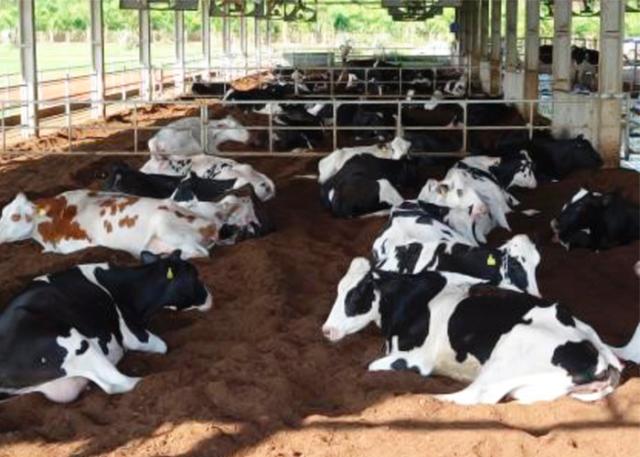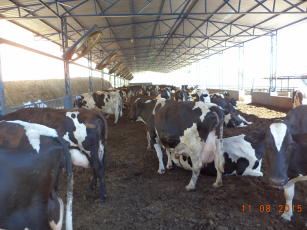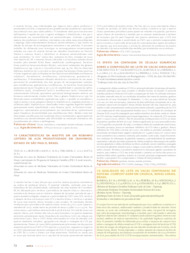More comfortable confinement sparks the interest of dairy farmers
More comfortable confinement sparks the interest of dairy farmers
A type of confinement that increases animal well-being and is already used in temperate countries is under assessment for Brazilian conditions.The technique has drawn the attention of farmers in the country with an eye on the results related to herd management, increase in productivity and animal health. And there is name for it, which is increasingly mentioned in the national production sector: "Compost Barn".
It is an alternative to the confinement milk production systems known as free stalls, in which the cows are constrained in stalls measuring a few square meters, or tie stalls, where the animals are raised in individual stalls, tied by chains. The Compost Barn system is characterized by leaving the animals free in the stable. Although they are still confined, the cows circulate at will and interact with each other, which enables them to exercise their social instincts within the group and rut more easily, which improves reproductive performance indicators.
This production system arrived in Brazil in 2011, and has been adopted in countries like the United States, Canada, the Netherlands and Israel since the mid-1980s. About 300 Brazilian farmers have already opted for the Compost Barn, either adapting their old free stalls or building a new system. However, there is still little national agricultural research information about its adaptability to conditions within the country. To bridge the gap, the Embrapa Dairy Cattle has conducted a study on the use of the Compost Barn since 2014. "As it is a technology that has been imported from countries with temperate climates, it is necessary to check its adaptability to tropical conditions", says the researcher Alessandro Guimarães, who is at the forefront of the study. The analyst Letícia Mendonça, who integrates Embrapa Dairy Cattle's team responsible for the study, informs that three properties in Minas Gerais that adopt the system are being monitored. Laboratories at Embrapa and at the Federal University of Juiz De Fora (UFJF) are analyzing milk quality and the microbiology of the organic compounds used in the bedded packs.
The main characteristic of the Compost Barn is the use of organic "bedding" covering the whole stable. In view of this characteristic, several other aspects of agronomic engineering were modified in comparison with traditional confinement systems. Stalls with latex or sand bedding, for instance, are abolished. Instead of concrete, which harms bovine hooves, the stable floor is lined with organic material like sawdust, peanut hulls, or another organic material that is low cost and easy available for the farmer.
From bedding to fertilizer
The bedded packs are in contact with the soil, at a height between 20cm and 50cm. The cows defecate and urinate in the material, beginning to the process called composting, which controls the decomposition of organic materials. In the Compost Barn's case, cow droppings undergo semi-aerobic composting (in contact with air). To have that effectively occur, the bedding must always be dry and have constant aeration, which is obtained through fans and with scarification (revolvement of the material with tractors and mechanical hoes) twice a day. The compost is removed and replaced from time to time. Depending on the management, the bedded pack can be used in the stable for up to a year. After the substitution for a new compost, the old material can be sold as organic fertilizer or used in the property to fertilize the soil, which gives the process an important environmental appeal.
Viability still requires testing
Nevertheless, researchers are still cautious about the system. "We need to have further studies to give farmers solid answers about economic viability, with regard to the costs of implementation and maintenance of the system. It is also necessary to broaden knowledge on bedded pack microbiology, on the incidence of mastitis, and on milk quality", Guimarães ponders.
Looking for answers to such issues, on November 17 Embrapa Dairy Cattle held a workshop on the subject that gathered researchers, professors, veterinarians and farmers. The audience, more than two hundred participants in an event that was thought to only interest scholars of the area, positively surprised the organization, and demonstrates the great curiosity about the Compost Barn system in the sector.
Although scientific rigor has focused the debate on the disadvantages of the system, such as the high initial investment and the late return on invested capital, the excitement remains high. ABecause, according to the Argentinian dairy farmer Cristian Chiavassa, who gave a lecture during the workshop, the cost of implementing the of Compost Barn system can even be 50% cheaper than the free-stall one. The expectation is that the end system costs around R$ 4,500.00 per cow.
There are other disadvantages the experts listed, such as expenses with the organic material used in the bed, which can be high if it is not found close to the property; the difficulty of managing the compost, which requires daily scarification; the concentration of bacteria in the bedded packs, which still raises questions among specialists; the increase in electricity costs, to maintain good ventilation in the stable, etc. However, the environment appreciates the lower amount of waste deposited in nature (a major problem in the free stall and tie stall systems ) and its use as fertilizer. And the cows respond positively with the increase in milk production, less hoof problems, and improved reproductive performance indicators.
(Information on the Compost Barn can be obtained from Embrapa Dairy Cattle, through the e-mails leticia.mendonça@embrapa.br or alessandro.guimaraes@embrapa.br).
Translation: Mariana de Lima Medeiros
Rubens Neiva (MTb 5445/MG)
Embrapa Dairy Cattle
Press inquiries
gado-de-leite.imprensa@embrapa.br
Phone number: (32) 3311-7532
Further information on the topic
Citizen Attention Service (SAC)
www.embrapa.br/contact-us/sac/



